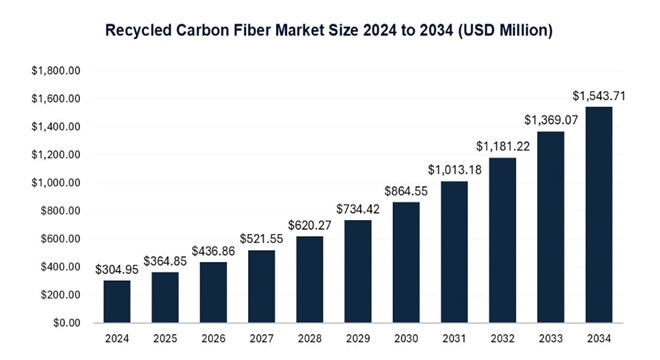
Carbon Fibre’s Circular Shift Gains Momentum with Scale‑up Data and Industrial Action
Global carbon fibre
recycling is expanding rapidly. Market size estimates vary, but conservative
figures peg it at US$ 197‑198 million in 2024, rising to US$ 382 million by
2030 at 13 % CAGR, while higher-end predictions project US$ 305 million in 2024
growing to USD 1.54 billion by 2034 at 17.6 % CAGR. Sharpest growth is expected
in Europe and Asia‑Pacific, where policy incentives and high demand from
automotive and aerospace are strongest.
Industry leaders such as
SGL Carbon, Toray, Teijin, ELG Carbon are actively scaling composite recycling
operations. Aerospace scrap leads sources at 43‑45 % share, while chopped
carbon fibre dominates product types at nearly 60 % in 2024. Pyrolysis remains
the most common recycling technique (70 % market share), with chemical
recycling soaring fastest (15–15.5 % CAGR).
Teijin has embedded
Life‑Cycle Assessment across its filament and recycling operations. It aims for
net‑zero emissions by 2050, deploying ISO 50001 and ISO 14001 systems and
reusing production heat for factory cooling. Teijin also produces biomass‑based
acrylonitrile carbon fibre and reclaims production scraps into pelletised
recycled fibre products.
Global carbon fibre reinforced
plastics (CFRP) waste is expected to reach about 20 kilotons annually by 2025,
as thousands of aircraft retire and components from wind turbine blades and
automotive composites enter the waste stream. Aviation consortia such as the
Aviation Circularity Consortium (ACC) estimate potential recovery of carbon
fibre from retired aircraft, while automakers and bike brands are beginning
partnerships with Teijin and Fujitsu to trace recycled material via blockchain
platforms.
India’s technical textiles
manufacturers should closely monitor recycled carbon’s emerging supply chains
and technology innovations. Domestic OEMs and composite yarn producers may
consider collaborations for mechanical and chemical recycling pilots and leverage
demand from mobility, sports and infrastructure sectors needing
high-performance circular materials. Manufacturers investing early in recycling
infrastructure, LCA practices and traceable supply chains can position India as
a sustainable fibre hub aligned with global circular economy mandates.
Circular carbon fibre
recycling is transitioning from niche pilot projects into a sizable industrial
economy. Material science innovation and scalable business models now offer a
pathway to reconcile high-performance composites with planetary boundaries and
long-term resource efficiency.
Global carbon fibre reinforced plastics (CFRP) waste is expected to reach about 20 kilotons annually by 2025, as thousands of aircraft retire and components from wind turbine blades and automotive composites enter the waste stream. Aviation consortia such as the Aviation Circularity Consortium (ACC) estimate potential recovery of carbon fibre from retired aircraft, while automakers and bike brands are beginning partnerships with Teijin and Fujitsu to trace recycled material via blockchain platforms.
If you wish to Subscribe to Textile Excellence Print Edition, kindly fill in the below form and we shall get back to you with details.








